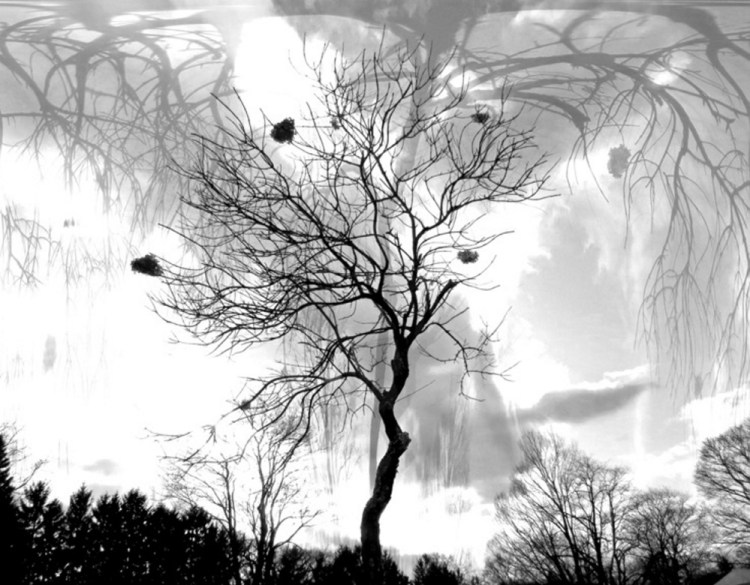One of the most exciting new venues in Maine is the Union of Maine Visual Artists’ gallery at CTN, next door to MECA’s Institute of Contemporary Art and on the same, buzzing block as June Fitzpatrick and SPACE Gallery. To date, the UMVA Gallery has featured a string of excellent shows highlighted by “Neurotica,” an extremely compelling survey of neo-surreal, subjectivity-oriented and process-driven art.
It now features 39 Maine photographers’ images of trees in “Branching Out,” organized by CMCA curator emeritus Bruce Brown. On the wall labels, Brown, the state’s most active and mobile curator, notes that 12 of the artists are Portland residents while the other 27 hail from 17 “communities along the Maine coast from Kittery Point to Sorrento and inland from Bangor to Blanchard.” It’s an interesting comment insofar as it reveals both Brown’s attempt to be as geographically broad as possible and the prevalence of Portland as the primary base of operations for active Maine artists.
(Disclosure: I am on editorial board of the Maine Arts Journal: The UMVA Quarterly, but I have never been a UMVA member nor involved with the gallery programing.)
“Branching Out” is a low-barrier curatorial theme. It’s accessible yet open enough for a massive range of content. Consequently, Brown is able to gather a group of artists whose work varies from the very cutting edge of contemporary practices to straightforward landscape photography that seeks to succeed through simple aesthetic appeal. If you are looking for beautiful photographs, you’ll find them. This, however, is where the CTN space interrupts a bit: It is more of a nonprofit office than a handsome white box gallery.
However, “Branching Out” is a highly energized show that succinctly gathers an impressive number of Maine’s best contemporary talents. I was particularly pleased to see Cig Harvey’s “Kendall at Beauchamp,” a 2014 Chromogenic print showing a young woman looking over her shoulder from a car seat with enough images on reflected glass to make Richard Estes dizzy. It’s not Harvey’s strongest work, but even her B game is superb. Harvey is a Rockland artist, and Brown lists both the artist’s municipality and whether the artist is a UMVA member (most are not); it’s a nice touch.
The strongest work in “Branching Out” leans towards the conceptual, although most blends contemporary content with aesthetic appeal. Shoshannah White (Portland), for example, is represented by a pair of small square tintypes heavy on black and floated from the wall. They combine old-fashioned technique with a spry contemporary feel. One looks like a wizened wet plate tamarack while the other feels like a photogram of an ash branch. Together, they sizzle exquisitely. Cole Caswell’s (Peaks Island) similarly old-fashioned-seeming California scene of a pair of cactuses is boyishly suggestive, but genuinely funny as one, bending flaccidly, echoes a distant street light. Tonee Harbert’s (Portland) ode to elms hit home with me, as I hail from what used to be known as Elm City before Dutch elm disease devastated the grand old trees and my entire hometown landscape. Also worthy of note are DM Witman’s (Warren) and Dana Strout’s (Camden) hallucinatory forest scenes. Todd Watts’ (Blanchard) “Blanchard Weather Report, 5-27-2015” is a dreamlike sky fabric of trees, seemingly woven into a grid by their gossamer branches. I have been interested in Ni Rong’s (Rockport) anonymous though performative self-portraits in the Maine landscape, and her single piece is particularly successful in this largely unsupportive context: It depicts a woman in an Asian-style fitted red dress walking, back to us, into a snowy birch landscape. It is a poignantly improbable and perplexing proposition held together in a beautiful photograph.
“Branching Out” is able to quietly branch out from simple aesthetic landscapes toward meditations on environment, place and identity because the premise is so broad. Consequently, it offers an excellent stage for works, like Rong’s, that take on issues of identity. However unlikely, it makes for an interesting contrast to “Ann Hirsch: Sharing Love” next door at the Institute of Contemporary Art.
“Sharing Love” comes down in a week and is worth seeing if you are interested in social media frontiers, online sex culture, or contemporary perspectives on gender identity. Hirsch is also featured in an online exhibition hosted by the New Museum: “It is I, Ann Hirsch, Horny Lil Feminist.” (When Portland hosts such cutting-edge contemporary art, it’s hard to feel that the city is fading as an art center.) Hirsch’s work isn’t necessarily successful, but it introduces some important topics, particularly about how social media and online communities have transformed our personal lives and dissolved the boundaries between our private and commercial selves. Hirsch’s direct involvement with online sexuality and pornography ostensibly claims to be serious or ironical with the pretense of operating at a critical remove from online sexworker culture (“camwhore”), but rarely, if ever, does her work transcend the popular culture trap of attention addict. It’s feminism, we can presume, because Hirsch says so, but does it help move the culture in a healthier direction, or does her admitted complicity drag it down? Hirsch’s work raises interesting questions, but, as feminist culture, it’s more Waterloo than highwater mark.
“Sharing Love” troublingly assumes a sympathetic “girls-club” audience (and a “lurker” mentality from the XY side of cis-ciety), so Hirsch’s message to her audience is little more than an elbow nudge to our ribs and a breathy “Right? Right!?” In this sense, “Sharling Love” is a much lazier production than the low-barrier “Branching Out,” in which curator Brown leaves his artists to succeed – or not – on their own.
“Branching Out” and “Sharing Love” make for odd neighbors on Congress Street, but they fit together fine as reminders of the range and energy of the very-much-alive contemporary art scene in Portland.
Freelance writer Daniel Kany is an art historian who lives in Cumberland. He can be contacted at: dankany@gmail.com
Send questions/comments to the editors.



